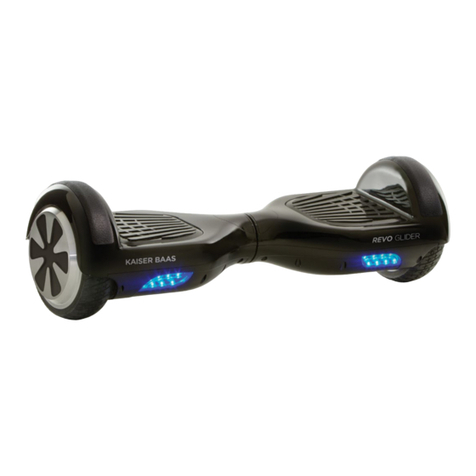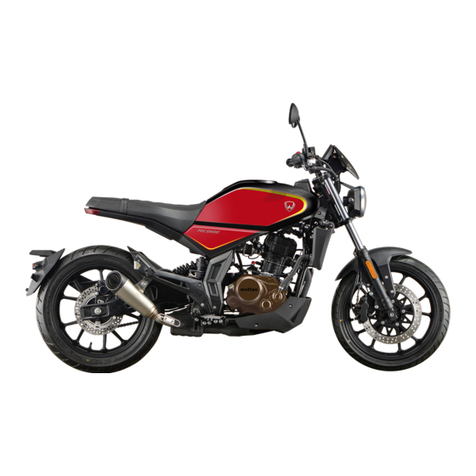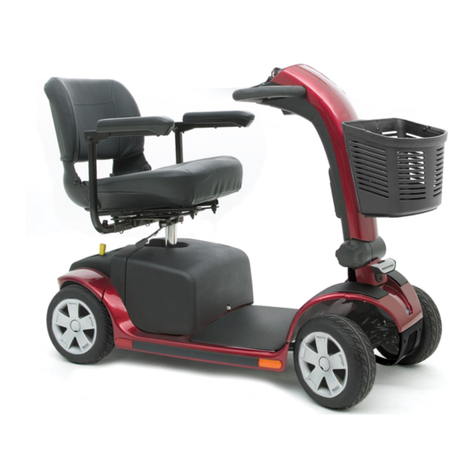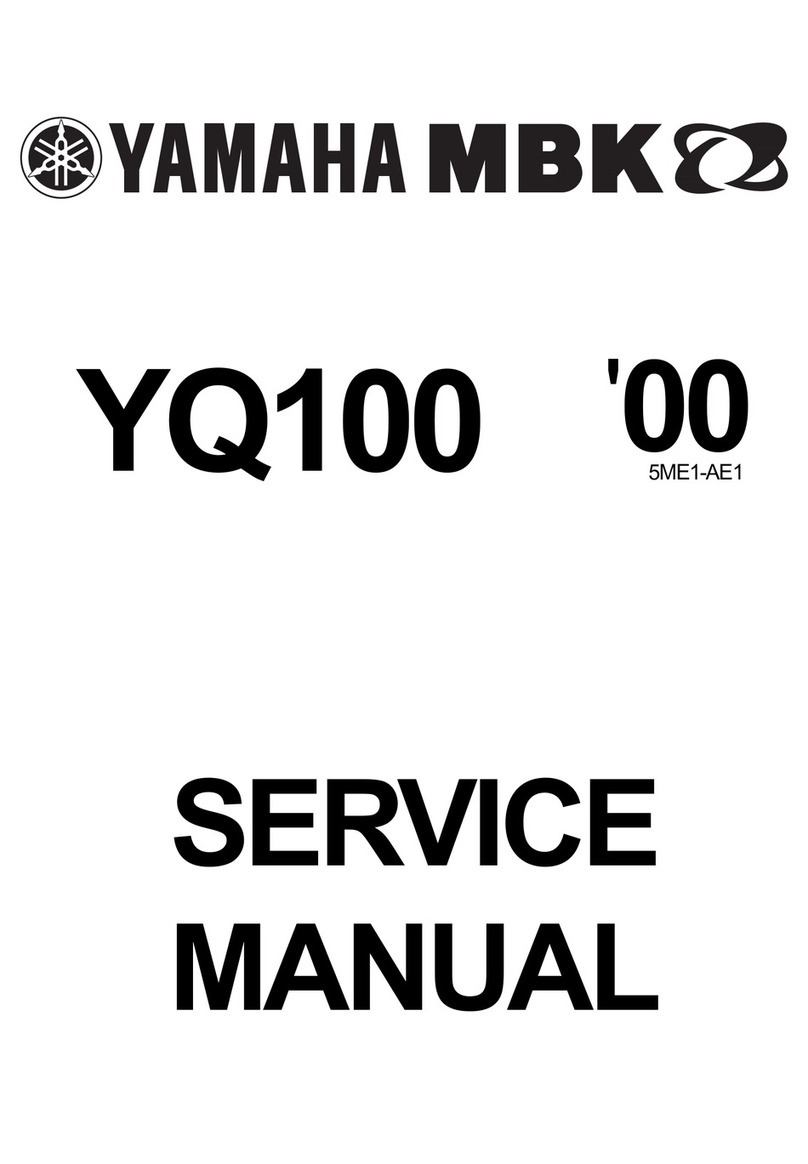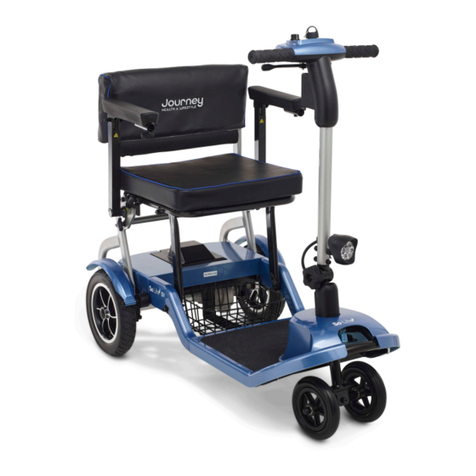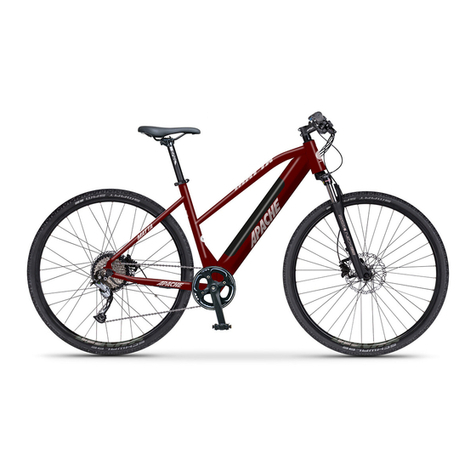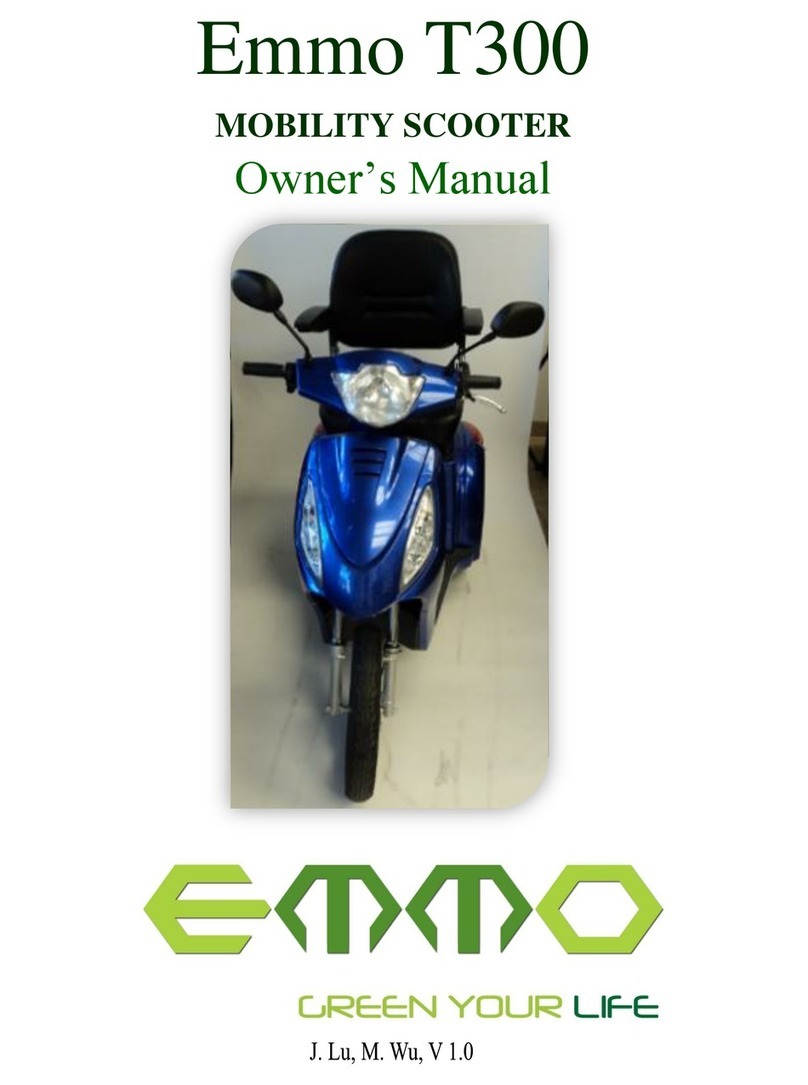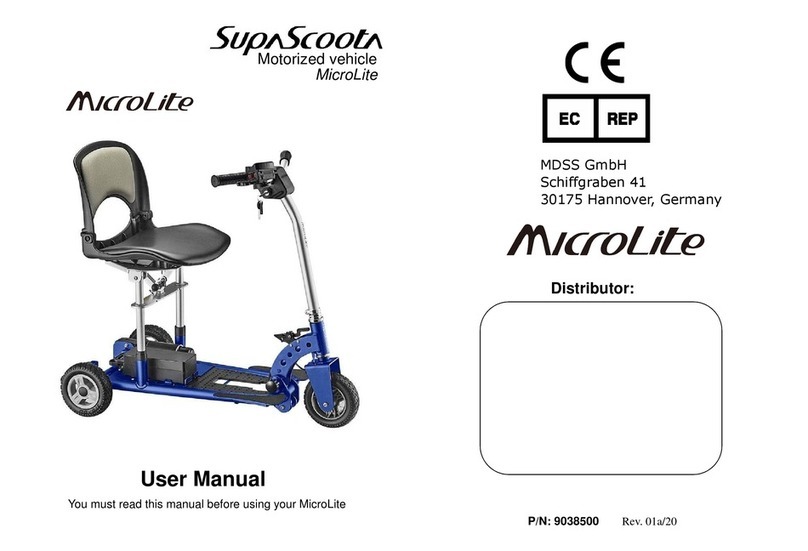trail ripper TR36v User manual

ELECTRIC MINICROSS BIKE (TR36v)
OWNER’S MANUAL
Read and understand this entire manual before using!
NOTE: Manual illustrations are for demonstration purposes only.
Illustrations may not reflect exact appearance of actual product.
Specifications subject to change without notice.
OFF ROAD USE ONLY!!!
NEVER OPERATE THIS VEHICLE IF YOU
ARE UNDER AGE 12!!!

INTRODUCTION
Thank you for purchasing this product. Outlined in this manual is the proper care and
maintenance that your vehicle requires. Following these instructions will ensure a long
trouble-free operating life of this vehicle and your satisfaction with it.
This owner’s manual corresponded to the latest Trail Ripper 36V at the time of printing.
Slight deviations resulting from continuing development and design can, however, not
be completely excluded. All specifications are non-binding, we reserve the right to
modify or delete technical specification, parts, design, etc…without prior notice.
SAFETY WARNINGS
This vehicle is NOT A TOY and is ONLY to be used in closed off areas remote from
public road traffic. Never permit children under age 12 to operate this vehicle.
Adult’s supervision is required if children under age 16.
WARNING:
Riding this vehicle can be a hazardous activity. Certain conditions may cause the
equipment to fail without fault of the manufacturer. Like other vehicles, the Trail Ripper
can and is intended to move, and it is therefore possible to lose control, fall off and/or
get into dangerous situations that no amount of care, instruction or expertise can
eliminate. If such things occur you can be seriously injured or die, even when using
safety equipment and other precautions. RIDE AT YOUR OWN RISK AND USE COMMON
SENSE.
This manual contains many warnings and cautions concerning the consequences of
failing to maintain, inspect or properly use your mini dirt bike. Because any incident can
result in serious injury or even death, we do not repeat the warning of possible serious
injury or death each time such a possibility is mentioned.
APPROPRIATE RIDER USE AND PARENTAL SUPERVISION
This manual contains important safety information and use the tips to help you and
your child operate and handle the mini dirt bike. Carefully read the manual in its entirety
together with your child before letting your child ride it for first time. The manual also
contains important information on servicing the vehicle.
It is your responsibility to review the manual and make sure that all riders understand
all warnings, cautions, instructions and safety topics and assure that the riders are able
to safely and responsibly use this product and protect your child from injury. We
recommend that you periodically review and reinforce the information in this manual
with your child, and that you inspect and maintain your children’s vehicle to insure their
safety. The recommended rider age of 12 years is only an estimate, and can be affected
by the rider’s size, weight or skills. Any rider unable to fit comfortably on this vehicle
should not attempt to ride it.
It is important and necessary to conduct the technical training for your child before first
use. To get the training information, please contact the dealer who you purchased the
vehicle from. Before your child completes the training, do not let your child use this
vehicle.
Children often underestimate or fail to recognize the dangerous situation, you should
make it clear to your child that they should not, under any circumstances, operate the
vehicle without supervision and that your child may only drive at speeds that are
commensurate with the child’s riding ability and other road conditions.
A parent’s decision to allow his or her child to ride this vehicle should be based on the
child’s maturity, skill and ability to follow rules.

Keep this product away from small children younger than age 12 and remember that
this product is intended for use only by persons who are, at a minimum, completely
comfortable and competent while operating the vehicle
Do not exceed 125lbs (55kgs) total weight on this vehicle. Rider weight does not
necessarily mean a person’s size is appropriate to fit or maintain control of this vehicle.
Do not touch the brakes or motor on your bike when in use as they can become very
hot.
ACCEPTABLE RIDING PRACTICES AND CONDITIONS
Always check and obey any local laws or regulations which may affect the locations
where the vehicle may be used.
Ride safely. Watch out for potential objects that could catch your heel or force you to
swerve suddenly or lose control. Be careful to avoid pedestrians, skaters, skateboards,
scooters, bikes, children or animals who may enter your path, and respect the rights
and property of others.
This vehicle is meant to be used only in controlled environments free of potential traffic
hazards and not on public streets or sidewalks. Do not ride your vehicle in any areas
where pedestrians or product traffic is present.
Do not activate the speed control on the hand grip unless you are on the vehicle and in
a safe, outdoor environment suitable for riding.
The vehicle was manufactured for performance and durability but is not impervious to
damage. Jumping or other aggressive riding can over-stress and damage any product,
including this vehicle, and the rider assumes all risks associated with high-stress
activity. Be careful and know your limitations. Risk of injury increases as the degree of
riding difficulty increases. The rider assumes all risk associated with aggressive riding
activities.
Maintain a hold on the handlebars at all times.
Never carry passengers or allow more than one person at a time to ride the vehicle.
Never use near steps or swimming pools.
Keep your fingers and other body parts away from the drive chain, steering system,
wheels and all other moving components.
Never use headphones or a cell phone when riding.
Never hitch a ride with another vehicle.
Do not ride the vehicle in wet or icy weather and never immerse the vehicle in water, as
the electrical and drive components could be damaged by water or create other
possibly unsafe conditions.
The vehicle is intended for use on flat, level ground without loose debris such as rocks

or gravel. Wet, slick, bumpy, uneven or rough surfaces may impair traction and
contribute to possible accidents. Do not ride the vehicle in mud, ice, puddles or water.
Avoid excessive speed that can be associated with downhill rides. Never risk damaging
surfaces such as a carpet or flooring by use of the vehicle indoors.
Do not ride at night or when visibility is limited.
PROPER RIDING ATTIRE
Always wear proper protective equipment such as an approved safety helmet, elbow
pads and kneepads. A helmet may be legally required by local law or regulation in your
area. A long-sleeved shirt, long pants and gloves are recommended. Always wear
athletic shoes, never drive barefooted or in sandals, and keep shoelaces tied and out of
the way of the wheels, motor and drive system.
USING THE CHARGER
The charger supplier with the vehicle should be regularly examined for damage to the
cord, plug, enclosure and other parts, and in the event of such a damage, the bike must
not be charged until the charger has been repaired or replaced.
Use only with the recommended charger.
Use caution when charging.
The charger is not a toy. Charger should be operated by an adult.
Do not operate charger near flammable materials.
Unplug charger and disconnect from bike when not in use.
Always disconnect from the charger prior to wiping down and cleaning the vehicle with
liquid.
FAILURE TO USE COMMON SENSE AND HEED THE ABOVE WARNINGS INCREASES
RISK OF SERIOUS INJURY. USE WITH APPROPRIATE CAUTION AND SERIOUS
ATTENTION TO SAFE OPERATION.
LOCATION OF WARNING STICKER
Sticker A

Sticker B
PIN LOCATION
PIN is stamp marked on an aluminum plate that is riveted on the steering column.
PIN means the Product Identify Number which is unique for each unit.

FUNCTION OF 3 SPEED ADJUSTABLE SWTICH
The 3-speed switch is located under the left side of motor cover.
Below the switch, there are 3 letters representing the different speed as follows:
H: high speed around 19 Mph.
L: lowest speed around 7 Mph.
M: middle speed around 14 Mph.
●HAND BAR CONTROLS
1. Rear brake lever
2 Front brake lever
3 Key switch
4 Meter of battery life
ATTENTION:
STOP use and charge the battery once the indicator turn into red and yellow light only
5 Stop switch
6 Throttle
7 Rubber grip

MAIN PARTS
1
Plastic set (5 pcs)
10
Complete front wheel
19
Rear brake disc
2
Handle bar grips (pair)
11
Front brake disc
20
Rear wheel complete
3
Throttle sleeve
12
Motor shroud
21
Rear drive sprocket
4
Throttle assembly
13
Front fork set
22
Drive chain
5
Front brake lever
14
3 speed switch
23
Battery (36V Li-po)
6
Handlebars
15
Motor
24
Chain guard
7
Rear brake lever
16
Side stand
25
Battery box
8
Key switch barrel
17
Brake pad set (2 pcs)
26
Controller 36v
9
Front mudguard
18
Rear shock assembly
27
Handlebar clamps

BEFORE YOU BEGIN
Remove contents from box. Remove the foam separators that protect the components
from damage during shipping. Inspect the contents of the box for scratches in the paint,
dents or kinked cables that may occurr during shipping. Because the product was 85
percent assembled and packed at the factory, there should not be any problems, even if
the box has a few scars or dents.
MAKE SURE KEY SWITCHES ARE TURNED “OFF”BEFORE CONDUCTING ANY
PROCEDURES.
Estimated Assembly and Set-Up Time
We recommend assembly by an adult with experience in motorbike or bicycle
mechanics.
Allow up to 30-40 minutes for assembly.
Allow up to 4-8 hours for initial charge.
Required Tools
Some tools may be supplied; however, we recommend the use of mechanic’s grade
tools. Use the supplied tools only as a last resort.
The list of tool required is as follows
·Open end wrench 10mm / 13mm/ 17mm / 22mm
·Allen wrench 5mm / 6mm/ 8mm
Assembly illustration and instruction
ASSEMBLY HANDLEBAR
Caution: Failure to properly adjust and tighten the bolts that affix the handlebar can
cause you to lose control and crash.
1. place the handlebar (A) in the bottom
clamp, then cover the upper clamp (B)
on the handlebar and install the 4pcs
bolt (C)
2. Place the handlebar in the upright and
vertical position, then tighten all the
bolts securely with 10mm socket
spanner.
A:handlebar
B:upper clamp
C:bolt M8X20 4pcs

ASSEMLY MUDGUARD
1. mount the bolt (D) through the
mudguard fixing bracket into the
splintage (B) and tighten it.
2. mount the bolt (C) bottom-up
through the mudguard rear hole into
the triple clamp (B) and tighten it.
A:mudguard
B:bottom triple clamp
C:bolt M6X16
D: bolt M6 x16
ASSEMBLYNUMBER BOARD
1. Fix the number board (A) into the
location pillar of mudguard (E)
2. Install the bolt (C), bush (D) into the
upper triple clamp (B) and tighten the
bolt with 10mm socket spanner.
A:Number board
B:upper triple clamp
C:bolt M6X25
D:bush 8X1.0X15
E:location pillar
ASSEMLY FRONT WHEEL AND REAR SHOCK ABSORBER
1. put the wheel (A) on the right position
to place the disc (E) between the
brake caliper pad.
2. mount the axle (B) through the left
fork, bush (D), wheel, bush (D) and
right fork in sequence, and then fix
the nut (C) and tighten it.
A:wheel
B:wheel axle M12X160
C:nut M12
D:bush 16X1.5X13 2pcs
E:brake disc

1. Uplift the frame to align the shock (A)
mounting hole to the swing arm joint
hole.
2. Fix the bolt (B) through the shock
mounting hole and swing arm joint and
tighten the nut (C) securely with 10mm
and 13mm open end wrench
A:shock absorber
B:bolt M8X40
C:nut M8
INFLATING THE TYRES
NOTE: The tyres are inflated when shipped, but they invariably lose some pressure
between the point of manufacturing and your purchase. Always inflate the tyres to the
correct PSI before first time use.
Please read the specification sheet to get the information of tyre pressure.
Using a bicycle-style tyre pump to inflate the tyre to the PSI indicated on the sidewall of
the tyre.
NOTE: The pressurized air supplies found at gasoline stations are designed to inflate
high-volume automobile tyres. If you decide to use such an air supply to inflate your
tyres, first make sure the pressure gauge is working, then use very short bursts to
inflate to the correct PSI. If you inadvertently over-inflate the tyre, release the excess
pressure immediately.
Important information of use guider for tyre
Note: Tyre is the only contact between the vehicle to the road, the safety of various
driving activity depends on the small area of tyre where it contacts with the road.
Therefore, it is very important to keep the tyre in good condition at all times and use the
correct size and standard tyre to replace the old ones.
Guide:
Tyre assembly and disassembly:
It is strongly recommended that the tyre assembly and disassembly should be done by
an authorized technician with necessary skills.
Tyre inflating pressure:
It is very important to keep the tyre in proper pressure and check the tyre pressure

before use. The inflating should be done while the tyre is cold.
Tyre maintenance:
Tyre tread depth should be checked regularly (shallower tread means less grip of tyre).
You must stop to use the vehicle if the tyre is pierced, disassemble the tyre and check it
carefully. Tyre maintenance should be done by an authorized technician. Tyre should
be replaced immediately when it is distorted or damaged.
Tyre replacement:
It is important to use the correct size and standard tyre as per our specification (see
details in technical specification sheet).
Don’t use the used tyre if you are not sure its previous service condition.
Tyre aging:
Tyre aging is unavoidable even the tyre is not ever used or just used a few times. Tyre
aging is mainly reflected in the cracked section on side of tyre and tyre tread,
sometimes the tyre is distorted as well. The used and aged tyre should be checked and
confirmed if it is ok to use again by an authorized technician.
BEFORE RIDING
Charging the Battery
You shall use the charger which should match this bike (never use a charger from a
different model). Before charging, you must turn the power switch to “OFF” and pull out
the key. Keep the charger in a dry and ventilative condition when it’s working.
The charger is designed for indoor use only. Keep the charger away from water to avoid
short circuit. Don’t even use it in a dampening, combustible or explosive environment.
Do not remove the plug by pulling the cord, always grip the charging port by its metal
body.
Firstly connect the output plug of the charger with the socket of the battery case
properly, and then insert the input plug into the AC electrical outlet. And the charger
indicator will light on, which means it’s on charging.
When the light turns from Red to Green, it means the battery has been fully charged.
Usually it will take about 4-6 hours to recharge the battery depend on different status.
However, it’s a good suggestion that it’s be charged for additional 2 hours after the light
turn to green if you have time (It is good for the service life of the battery).
Do not charge it for more than 10 hours to avoid overcharging and damaging the
battery. After the light turns GREEN, the charger is in the state of trickle electric current
and “fill slowly " and maintain the state. If you are going to be out for a long time, you

should pull out the charger plug, especially in hot weather.
The charger will become warm during charging, so keep charger away from any heat
source. Please always keep the charger dry and clean. The electronics inside contain
high voltage, so please don't disassemble the charger by yourself.
After charging, please pull the input plug out of the electrical outlet first, and then pull
out the output connecting plug from the battery case. Do not let the charger plugged
into the battery or electrical outlet for a long time, which may damage the charger and
cause the fire.
While charging, please keep it out of the reach of children. Do not put anything on top
of the charger when in use, and prevent any liquid, metal or metal fillings to permeate
into the charger.
You can also remove the battery from the bike and then charge it.
Do not touch any poles in the battery case with your hands when the battery is removed
for charging. Also the charging connector poles cannot be touched with any metal or
any other material that conducts electricity, otherwise it may cause short circuit.
If you don’t ride your bike for a long time, the battery should be charged at least one
time per month. This will ensure the battery life. DO NOT use in the state of low battery
capacity. Do not leave your battery in a fully discharge state for long periods of time.
The battery will continue to self-discharge, resulting in damage.
Avoid any contact with water when charging your battery. If a plug or socket gets wet,
dry it completely before using.
When charging, if there is a peculiar smell or the temperature is extremely high, please
stop charging immediately and send to the local distributor or to the Customer Service
Center.
WARNING: rechargeable batteries are only to be charged under adult supervision.
Always disconnect your electric motor bike from the charger before cleaning with
liquid.
NOTE: Chargers have built-in over charge protection to prevent battery from being over
charged. Charger will get warm during use, this is normal for some charges and is no
cause for concern. If your charges does not get warm during use, it does not mean that
it is not working.
Be sure to properly align the groove on the charger input port with the corresponding
socket on the vehicle and tighten threads; otherwise, no charging action will occur.

There are 2 charge port on this vehicle, one is located below the handlebar of battery box, and
the other is fitted on the left side of motor cover ( see above picture).
Warning: Failure to recharge the battery at least once a month may result in a battery
that will no longer hold a charge.
SAFETY REMINDERS
PRE-RIDE CHECKLIST
Loose Parts
Check and secure all fasteners before every ride. Make sure steering stem clamp bolts
are locked properly in place. There should not be any unusual rattles or sounds from
loose parts or broken components. If you are not sure, ask an experienced mechanic to
check.
Brake
Check the brake for proper function. When you squeeze the lever, the brake should
provide positive braking action.
Frame, Fork and Handlebars
Check for cracks or broken connections. Although broken frames are rare, it is possible
for an aggressive driver to bash into a curb or wall and wreck and bend or break a frame.
Get in the habit of inspecting yours regularly.
Tyre Inflation

Periodically inspect the tyres for excess wear, and regularly check the tyre pressure
and re-inflate as necessary. If you get a flat tyre, the inner tube can be patched or a new
tube can be purchased from an authorised repair shop.
Safety Gear
Always wear proper protective equipment such as an approved safety helmet, elbow
pads and kneepads. Always wear shoes (lace-up shoes with rubber soles), never drive
barefooted or in sandals, and keep shoelaces tied and out of the way of the wheels,
motor and drive system
ATTENTION
We recommend checking all tightened parts after the first time use. Special attention
should be paid to the following parts:
■Footrest
■Engine sprockets (Racing version only)
■Shock absorber
■Engine bolts and nuts
■Rear sprocket
TECHNICAL SPECIFICATION SHEET
Motor type
500W 36V
Rated torque (500W)
1.9 N.m/ rpm
Battery
36V 10AH li-ion battery
Charger
100-240V/50-60 Hz
Transmission
Chain drive
Front suspension
Telescopic fork
Rear suspension
mono shock absorber
Tyre
front & rear 2.50-10 with 4.00 P.s.i operation pressure
and 36 P.s.i Max. inflate
Brake system
front and rear disc brake with mechanical control
Rated loading capacity
55KG
Max. speed
19 MPH
Range per charge
12 miles
Dry Weight
26kgs
Dimension (mm)
1120×570×800
Seat height (mm)
570
Min. Ground Clearance(mm)
225mm
Wheelbase (mm)
850mm
REPAIR AND MAINTENANCE
Turn key switch “OFF”before conducting any maintenance procedures.

Replacing The Fuse
WARNING:
To prevent shock, please follow above instructions accordingly and do not skip or
combine any steps.
Adjusting chain
Checking the drive chain periodically to ensure longer chain life.
Always keep it lubricated and tighten the chain as follows:

Step 1 Use the cross screwdriver to loose the 3pcs screws and remove the chain
cover.
Step 2: Loose the rear wheel axle nut with 17mm and 14mm open spanner, then loose
the screw of caliper bracket, adjust the chain adjuster.
Step 3: The chain tension is in good condition while the gap is about 5mm between
chain to lowest parts of swing arm. Lock all the nuts and screws, check the
wheel alignment and then re-attach the chain cover.
Adjusting brake
Step 1:
To adjust the brake tension, thread the brake lever
adjuster in or out 1/4 or 1/2 turn until the required
brake adjustments is attained.

Most of brake adjustments are complete at this step, if the brake still need the further
adjustment,
Step 2:
With 10mm open spanner, loose the brake cable
and adjust the brake caliper arm to make the cable
length>30mm from arm to the pillar.
Step 3:
With 8mm open spanner to loose the nut of
friction pad, and with 2.5mm allen wrench to
adjust the inner screw for friction pad.
Check
To check the wear of front and rear brake pads A, simply inspect the brakes calipers as
shown in the below picture. The thickness of the lining on the ends of the four
pads should never be less than 1mm.
Should the lining be thinner, immediately replace
the brake pads.
We recommend having the brake pads replaced by
an authorized dealer.
Warning:
The brake is capable of causing the electric bike to skid the tyre throwing an
unsuspecting rider. Practice in an open area free from obstacles until you are familiar
with the brake function. Avoid skidding to stop as this can cause you lose control or
damage the rear tyre.
Testing the Brakes
To use the brake, squeeze the lever to increase the pressure on the brake. The brake
lever is fitted with a cable adjuster to compensate for cable stretch and/or to fine-tune
the lever movement to brake engagement. If brake is not engaging properly, follow
instructions for adjusting the brakes.

Chain and sprocket
The chain will typically have a “loose spot”and “tight spot”corresponding with a
particular sprocket rotational position. This is normal and common to all chain-driven
products due to run-out to tolerance of the free wheel and sprocket. The chain should
be adjusted to the ideal tension with chain in the tightest spot.
Proper chain alignment must be maintained. The wheel must not be skewed, if the chain
is noisy or rough running, check the lubrication, tension and alignment of sprockets, in
that order.
Warning:
To avoid a pinch or injury, keep fingers away from moving sprockets and chain.
Battery disposal
CONTAINS LI-ION BATTERIES.
BATTERIES MUST BE RECYCLED.,
Charger
The charger supplied with the bike should be regularly examined for damage to the
cord, plug, enclosure and other parts, and, in the event of such damage, the bike must
not be charged until is has been repaired or replaced.
USE ONLY WITH THE RECOMMENDED CHARGER
TROUBLESHOOTING GUIDE
Problem
Possible cause
Solution
Vehicle does not run.
Undercharged battery.
Charge the battery. A new battery should have been
charged for 4-6 hours before using the vehicle.
Check all connectors. Make sure the charger connector
is tightly plugged into the charging port, and that the
charger is plugged into the wall.
Make sure power flow to wall outlet is on.
Charger is not working.
You may check to see if your charger is working by
using a volt meter or asking the authorized service
center to test your charger for you.
Vehicle was running but
suddenly stopped.
Loose wires or connectors.
Check all wires and connectors to make sure they are
tight.
Burned-out fuse.
The fuse will burn out and automatically shut off the
power if the motor is overloaded.

An excessive overload could cause the motor to
overheat. Refer to replacing the fuse instructions of this
manual. Correct the conditions that caused the fuse to
burn out and avoid repeatedly burning out fuse.
Motor or electrical switch
damage.
Contact the authorized service center for diagnosis and
repair.
Short run time less than
15 minutes per charge
Undercharged battery
Charge the battery. A new battery should have been
charged for 4-6 hours before using the vehicle.
Check all wires and connectors. Make sure the battery
connector is tightly plugged into the charger connector,
and that the charger is plugged into the wall.
Make sure power flow to the wall outlet is on.
Battery is old and wil not
accept full charge.
Even with proper care, a rechargeable battery does not
last forever. Average battery life is 1 to 2 years
depending on vehicle use and conditions. Replace only
with a replacement battery.
Brakes are not adjusted
properly
Refer to brake adjustment instructions.
Vehicle runs Sluggishly.
Driving conditions are too
stressful.
Use only on solid, flat clean and dry Surfaces such as
pavement or level ground.
Tyres are not properly
Inflated.
The tyres are inflated when shipped, but they invariably
will lose some pressure between the point of
manufacturing and your purchase. Refer to tyre
instructions to properly inflate tyres.
Vehicle is overloaded.
Make sure you do not overload the vehicle by allowing
more than one rider at one time, exceeding the
maximum weight limit, going up too steep a hill or
towing objects behind the vehicle. If the vehicle is
overheated, the temperature circuit protector will slow
motor down and if the condition continues, will shut off
power to the motor. Correct the driving conditions that
caused the overheating, wait 5-10 minutes and then
resume riding. Avoid repeatedly overheating the unit.
Sometimes the vehicle
doesn’t run, but other
times it does.
Loose wires or connectors
Check all wires around the motors and all connectors
to make sure they are tight.
Motor or electrical Switch
damage.
Contact the authorized service center for diagnosis and
repair.

Charger gets warm
during use
Normal response to
Charger use
No action required. This is normal for some Chargers
and is no cause for concern. If your charger dose not
get warm during use, it does not mean that it is not
working properly.
Vehicle does not stop
when applying the
brake.
Brakes are not adjusted
properly
Refer to brake instructions to properly adjust Brakes.
Vehicle makes loud
noises or grinding
sounds
Chain is too dry
Apply a lubricant to the chain.
CIRCUIT DIAGRAM
Table of contents
